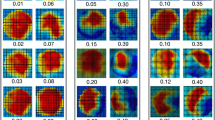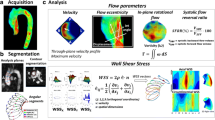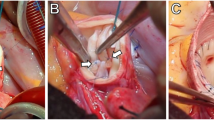Abstract
Bicuspid aortic valve (BAV) is often concomitant with aortic dilatation, aneurysm, and dissection. This valve lesion and its complications may affect positional and temporal wall shear stress (WSS), a parameter reported to regulate transcriptional events in vascular remodeling. Thus, this pilot study seeks to determine if the WSS in the ascending aorta (AAo) of BAV patients differs from control patients. Phase-contrast magnetic resonance imaging (PC-MRI) was used to perform flow analysis at the level of the AAo in 15 BAV and 15 control patients. Measurement of the aorta dimensions, flow rates, regurgitant fraction (RF), flow reversal ratio (FRR), temporal and spatial WSS, and shear range indices (SRI) were performed. The BAV and control group showed a significant difference between the circumferentially averaged WSS (p = 0.03) and positional WSS at systole (minimum p < 0.001). Regressions found that SRI (r = 0.77, p < 0.001), RF (r = 0.68, p < 0.001), and WSS at systole (r = 0.66, p < 0.001) were correlated to AAo size. The spatial distribution and magnitude of systolic WSS in BAV patients (−6.7 ± 4.3 dynes/cm2) differed significantly from control patients (−11.5 ± 6.6 dynes/cm2, p = 0.03). The SRI metric, a measure of shear symmetry along the lumen circumference, was also significantly different (p = 0.006) and indicated a heterogenic pattern of dilatation in the BAV patients.








Similar content being viewed by others
References
Bauer, M., H. Siniawski, M. Pasic, B. Schaumann, and R. Hetzer. Different hemodynamic stress of the ascending aorta wall in patients with bicuspid and tricuspid aortic valve. J. Card. Surg. 21:218–220, 2006.
Beroukhim, R. S., T. L. Kruzick, A. L. Taylor, D. X. Gao, and A. T. Yetman. Progression of aortic dilation in children with a functionally normal bicuspid aortic valve. Am. J. Cardiol. 98:828–830, 2006.
Buchanan, J. R., C. Kleinstreuer, G. A. Truskey, and M. Lei. Relation between non-uniform hemodynamics and sites of altered permeability and lesion growth at the rabbit aorto-celiac junction. Atherosclerosis 143:27–40, 1999.
Cecconi, M., M. Manfrin, A. Moraca, R. Zanoli, P. L. Colonna, M. G. Bettuzzi, S. Moretti, D. Gabrielli, and G. P. Perna. Aortic dimensions in patients with bicuspid aortic valve without significant valve dysfunction. Am. J. Cardiol. 95:292–294, 2005.
Cecconi, M., S. Nistri, A. Quarti, M. Manfrin, P. L. Colonna, E. Molini, and G. P. Perna. Aortic dilatation in patients with bicuspid aortic valve. J. Cardiovasc. Med. 7:11–20, 2006.
Cheng, C. P., D. Parker, and C. A. Taylor. Quantification of wall shear stress in large blood vessels using lagrangian interpolation functions with cine phase-contrast magnetic resonance imaging. Ann. Biomed. Eng. 30:1020–1032, 2002.
Cheng, C., D. Tempel, R. van Haperen, A. van der Baan, F. Grosveld, M. J. A. P. Daemen, R. Krams, and R. de Crom. Atherosclerotic lesion size and vulnerability are determined by patterns of fluid shear stress. Circulation 113:2744–2753, 2006.
Cripe, L., G. Andelfinger, L. J. Martin, K. Shooner, and D. W. Benson. Bicuspid aortic valve is heritable. J. Am. Coll. Cardiol. 44:138–143, 2004.
Della Corte, A., C. Bancone, C. Quarto, G. Dialetto, F. E. Covino, M. Scardone, G. Caianiello, and M. Cotrufo. Predictors of ascending aortic dilatation with bicuspid aortic valve: a wide spectrum of disease expression. Eur. J. Cardiothorac. Surg. 31:397–404, 2007.
Fedak, P. W. M., S. Verma, T. E. David, R. L. Leask, R. D. Weisel, and J. Butany. Clinical and pathophysiological implications of a bicuspid aortic valve. Circulation 106:900–904, 2002.
Firmin, D. N., G. L. Nayler, P. J. Kilner, and D. B. Longmore. The application of phase-shifts in NMR for flow measurement. Magnet. Reson. Med. 14:230–241, 1990.
Frayne, R., D. A. Steinman, C. R. Ethier, and B. K. Rutt. Accuracy of MR phase-contrast velocity-measurements for unsteady-flow. J. Magn. Reson. Im. 5:428–431, 1995.
Frydrychowicz, A., A. Berger, A. F. Stalder, M. F. Russe, A. Harloff, M. Langer, J. Hennig, and M. Markl. Diameter-dependence of aortic hemodynamics: does size matter? In: ISMRM 16th Annual Scientific Meeting, May 3–9, Toronto, ON, 2008. Abstract 2828.
Frydrychowicz, A., A. Harloff, B. Jung, M. Zaitsev, E. Weigang, T. A. Bley, M. Langer, J. Hennig, and M. Markl. Time-resolved, 3-dimensional magnetic resonance flow analysis at 3T: visualization of normal and pathological aortic vascular hemodynamics. J. Comput. Assist. Tomo. 31:9–15, 2007.
Grotenhuis, H. B., J. Ottenkamp, J. J. M. Westenberg, J. J. Bax, L. J. M. Kroft, and A. de Roos. Reduced aortic elasticity and dilatation are associated with aortic regurgitation and left ventricular hypertrophy in nonstenotic bicuspid aortic valve patients. J. Am. Coll. Cardiol. 49:1660–1665, 2007.
Haycock, G. M., G. J. Schwartz, and D. H. Wisotsky. Geometric method for measuring body surface area: a height weight formula validated in infants, children and adults. J. Pediatr. 93:62–66, 1978.
Holmes, K. W., C. U. Lehmann, D. Dalal, K. Nasir, H. C. Dietz, W. J. Ravekes, W. R. Thompson, and P. J. Spevak. Progressive dilation of the ascending aorta in children with isolated bicuspid aortic valve. Am. J. Cardiol. 99:978–983, 2007.
Hope, M. D., A. K. Meadows, T. A. Hope, K. G. Ordovas, G. P. Reddy, M. T. Alley, and C. B. Higgins. Evaluation of bicuspid aortic valve and aortic coarctation with 4D flow magnetic resonance imaging. Circulation 117:2818–2819, 2008.
Jin, S., J. Oshinski, and D. P. Giddens. Effects of wall motion and compliance on flow patterns in the ascending aorta. J. Biomech. Eng. 125:347–354, 2003.
Keane, M. G., S. E. Wiegers, T. Plappert, A. Pochettino, J. E. Bavaria, and M. G. S. J. Sutton. Bicuspid aortic valves are associated with aortic dilatation out of proportion to coexistent valvular lesions. Circulation 102:35–39, 2000.
Kozerke, S., M. B. Scheidegger, E. M. Pedersen, and P. Boesiger. Heart motion adapted cine phase-contrast flow measurements through the aortic valve. Magn. Reson. Med. 42:970–978, 1999.
Ku, D. N., C. L. Biancheri, R. I. Pettigrew, J. W. Peifer, C. P. Markou, and H. Engels. Evaluation of magnetic-resonance velocimetry for steady flow. J. Biomech. Eng. 112:464–472, 1990.
La Canna, G., E. Ficarra, E. Tsagalau, M. Nardi, A. Morandini, A. Chieffo, F. Maisano, and O. Alfieri. Progression rate of ascending aortic dilation in patients with normally functioning bicuspid and tricuspid aortic valves. Am. J. Cardiol. 98:249–253, 2006.
Lewin, M. B., and C. M. Otto. The bicuspid aortic valve: adverse outcomes from infancy to old age. Circulation 111:832–834, 2005.
Nichols, W., and M. F. O’Rourke. McDonald’s Blood Flow in Arteries: Theoretical, Experimental and Clinical Principles. London: Hodder Arnold, p. 19, 2005.
Papaharilaou, Y., D. J. Doorly, and S. J. Sherwin. Assessing the accuracy of two-dimensional phase-contrast MRI measurements of complex unsteady flows. J. Magn. Reson. Imaging 14:714–723, 2001.
Robicsek, F., M. J. Thubrikar, J. W. Cook, and B. Fowler. The congenitally bicuspid aortic valve: how does it function? Why does it fail? Ann. Thorac. Surg. 77:177–184, 2004.
Silber, H. A., D. A. Bluemke, P. Ouyang, Y. P. P. Du, W. S. Post, and J. A. C. Lima. The relationship between vascular wall shear stress and flow-mediated dilation: endothelial function assessed by phase-contrast magnetic resonance angiography. J. Am. Coll. Cardiol. 38:1859–1865, 2001.
Sluysmans, T., and S. D. Colan. Theoretical and empirical derivation of cardiovascular allometric relationships in children. J. Appl. Physiol. 99:445–457, 2005.
Warren, A. E., M. L. Boyd, C. O’Connell, and L. Dodds. Dilatation of the ascending aorta in paediatric patients with bicuspid aortic valve: frequency, rate of progression and risk factors. Heart 92:1496–1500, 2006.
Wilton, E., and M. Jahangiri. Post-stenotic aortic dilatation. J. Cardiothorac. Surg. 1:7–18, 2006.
Womersley, J. R. Method for the calculation of velocity, rate of flow and viscous drag in arteries when the pressure gradient is known. J. Physiol. 127:553–563, 1955.
Yasuda, H., S. Nakatani, M. Stugaard, Y. Tsujita-Kuroda, K. Bando, J. Kobayashi, M. Yamagishi, M. Kitakaze, S. Kitamura, and K. Miyatake. Failure to prevent progressive dilation of ascending aorta by aortic valve replacement in patients with bicuspid aortic valve: comparison with tricuspid aortic valve. Circulation 108:291–294, 2003.
Acknowledgments
Funded in part by NIH T32 HL72738, K24 HL081506, P50 HL084923, F31 EB006695 and a research grant from Siemens Medical. The authors thank the radiology and cardiology staff at The Children’s Hospital, Denver, specifically Dr. Vernon Chapman, Katherine Bushur, and Barret Daniels for assistance with this study.
Author information
Authors and Affiliations
Corresponding author
Rights and permissions
About this article
Cite this article
Barker, A.J., Lanning, C. & Shandas, R. Quantification of Hemodynamic Wall Shear Stress in Patients with Bicuspid Aortic Valve Using Phase-Contrast MRI. Ann Biomed Eng 38, 788–800 (2010). https://doi.org/10.1007/s10439-009-9854-3
Received:
Accepted:
Published:
Issue Date:
DOI: https://doi.org/10.1007/s10439-009-9854-3




